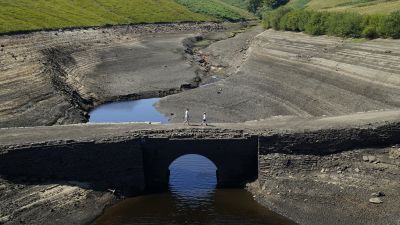Yorkshire officially enters drought for first time in four years

Yorkshire has officially entered drought status after a prolonged period of unusually dry weather.
The Environment Agency confirmed that the region joined other areas of the country, which moved to drought status last Friday, 12 August.
It comes after months of little rainfall led to exceptionally low river flows and reservoir levels falling across much of England.
High temperatures, including last week’s heatwave, continue to put pressure on the water environment and wildlife, the agency said.
Victoria Slingsby, environment planning and engagement manager for the Environment Agency in Yorkshire, said: "The high temperatures we are experiencing have exacerbated pressures on wildlife and our water environment in Yorkshire. These extreme weather conditions become more likely with climate change.
"We are experiencing some much-needed rain this week, but it will not be enough to correct weeks of dry weather, and it will take more prolonged rainfall to wet up soils and replenish rivers, reservoirs and groundwater levels.
"It’s important for everyone to manage the amount of water they are using in this exceptionally dry period."
Yorkshire Water has already announced that a hosepipe ban will come into effect later this month. The last drought in Yorkshire was in autumn 2018.
A spokesperson for the company said: "We have been carefully considering the weather forecasts, rivers and reservoir levels, and demand for water for some time due to the prolonged dry spell and record-breaking temperatures in the region.
"The declaration of drought does not impact our temporary use ban, which will come into place on 26 August, and we will continue to work closely with the Environment Agency on measures in our pre-agreed drought plan that will protect water supplies and the local environment this summer and into next year."
What happens when drought is declared?
The National Drought Group - made up of government and agency officials, water companies and other groups such as the National Farmers’ Union (NFU) - is responsible for declaring a drought.
Agencies and water companies must take action to manage water supplies and protect the environment.
In England, the main organisations responsible for managing water resources during drought are the Environment Agency, water companies, and the government.
A number of other authorities are also involved in the response, such as environmental groups and local councils.
The Environment Agency (EA) uses a green, yellow, amber and red colour-coded system to plan and manage drought.
Green is used for 'normal' situations, while yellow indicates a period of prolonged dry weather. Amber means drought, or recovering drought, and red means severe drought.
Water companies also have their own plans, where they must state what they will do to reduce the demand for water during a drought.
There are a range of actions that can be taken to protect water supplies when needed. These include limiting non-essential water use (e.g. hosepipe and sprinkler bans), reducing mains pressure, and preventing leakage.
Water companies can apply for a drought order to take more water, but must first demonstrate that they have made efforts to save it.
Want a quick and expert briefing on the biggest news stories? Listen to our latest podcasts to find out What You Need To Know.